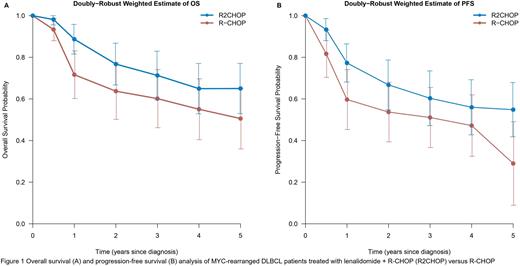Abstract
Introduction Patients with MYC rearranged (MYC-R) diffuse large B-cell lymphoma (DLBCL) generally have a poor prognosis following standard treatment with R-CHOP. Previously, we demonstrated in a single-arm phase II trial (HOVON-130) that addition of lenalidomide to R-CHOP (R2CHOP) is well-tolerated and yields similar complete metabolic remission (CMR) rates and survival as more intensive chemotherapy regimens such as DA-EPOCH-R [Chamuleau, Haematologica 2020]. In parallel with this single-arm interventional trial, a prospective observational screening cohort (HOVON-900) was open in which we identified all newly diagnosed DLBCL patients treated with R-CHOP in the Netherlands, including MYC-R patients who were not included in the interventional trial due to logistic reasons. These two cohorts enable to evaluate the added value of lenalidomide to R-CHOP in first-line treatment of newly diagnosed MYC-R DLBCL patients.
Methods In the single-arm, phase-II HOVON-130 trial, MYC-R DLBCL patients ≥ 18 years were treated with R-CHOP21 plus lenalidomide 15 mg day 1-15 for 6 cycles [Chamuleau, Haematologica 2020]. Additional inclusion criteria were Ann-Arbor stage II-IV, WHO performance status 0-3, ≥ one lesion of ≥ 1.5 cm on contrast-enhanced CT scan and ≥ one FDG-positive lesion on PET-CT scan.
In the observational screening study HOVON-900, MYC, BCL2 and BCL6 fluorescent in situ hybridization (FISH) diagnostics were advocated as part of routine procedures and reviewed by the HOVON Pathology Facility. As a control group, we selected MYC-R patients from this observational cohort who met the inclusion criteria for the interventional trial but were not included, and who were treated with standard R-CHOP. Clinical information at presentation and treatment and outcome data were retrieved from the Netherlands Cancer Registry.
We explored three statistical methods that account for baseline imbalances. First, we used multivariable regression, with baseline variables as covariates in the model. Second, we performed one-to-one matching on the IPI risk (low, intermediate, or high). Third, we performed inverse probability of treatment weighting (IPTW) using a propensity score. We calculated a propensity score for being included in the HOVON-130 trial based on the separate components of the IPI score (i.e., age, Ann Arbor stage, WHO performance score, extra-nodal localizations, serum LDH level), sex and rearrangement status. To allow for some degree of misspecification of the model for the propensity score, we used a doubly-robust estimator. Subgroup analyses were performed in single hit (SH: only MYC rearrangement), versus double hit and triple hit (DH/TH: MYC rearrangement with BCL2 and/or BCL6 rearrangement).
Results Patients from the interventional trial treated with R2CHOP (n=77) were younger than patients in the control cohort (n=56) treated with R-CHOP (median age 63 versus 70 years, p=0.018) and they were more likely to have a lower WHO performance score (p=0.013). Ann Arbor stage, LDH level, number of extranodal localizations and median days before treatment (15 and 19 in the R-CHOP and R2CHOP group, respectively) did not significantly differ between the groups.
Complete remission rates were 69.8% and 80.5% in the R-CHOP and R2CHOP group, respectively (p=0.209).
Multivariable analysis, 1:1 matching and weighting using the propensity score consistently showed improved outcome after R2CHOP with HRs of 0.53, 0.53, and 0.59 (Figure 1A), respectively, for OS, and 0.59, 0.53, and 0.60 for PFS (Figure 1B). In the subgroups determined by rearrangement status, we performed unadjusted OS and PFS analysis only, because we were not able to adjust for baseline imbalances because of the low number of events within the subgroups. Both SH patients and DH/TH patients tended to have a longer OS when treated with R2CHOP with HRs of 0.34 and 0.57, respectively. Similarly, for PFS the HRs were 0.66 in the SH subgroup and 0.48 in the DH/TH subgroup.
Conclusion In conclusion, this propensity score-adjusted comparison study supports the addition of lenalidomide to R-CHOP as a valuable treatment option for MYC-R DLBCL patients. R2CHOP can be administered on a full outpatient basis, with minimal hospitalization visits. Future studies will explore whether adding next-generation cereblon targeting antigens to R-CHOP can improve the observed effects.
Disclosures
Nijland:Roche: Research Funding; Takeda: Research Funding; Genmab: Consultancy. Kersten:Adicet Bio: Honoraria; Takeda: Honoraria; Roche: Honoraria, Research Funding; Novartis: Honoraria; Miltenyi Biotech: Honoraria; Kite, a Gilead Company: Honoraria, Research Funding; BMS/Celgene: Honoraria, Research Funding. Chamuleau:Gilead: Research Funding; Roche: Honoraria; Genmab: Research Funding; BMS/Celgene: Honoraria, Research Funding; Abbvie: Honoraria; Novartis: Honoraria.
OffLabel Disclosure:
Lenalidomide as immunomodulatory drug for patients with MYC-rearranged Diffuse Large B Cell Lymphoma
Author notes
Asterisk with author names denotes non-ASH members.


This feature is available to Subscribers Only
Sign In or Create an Account Close Modal